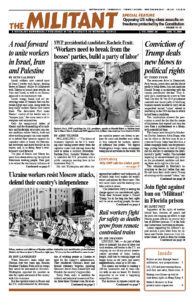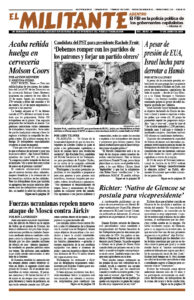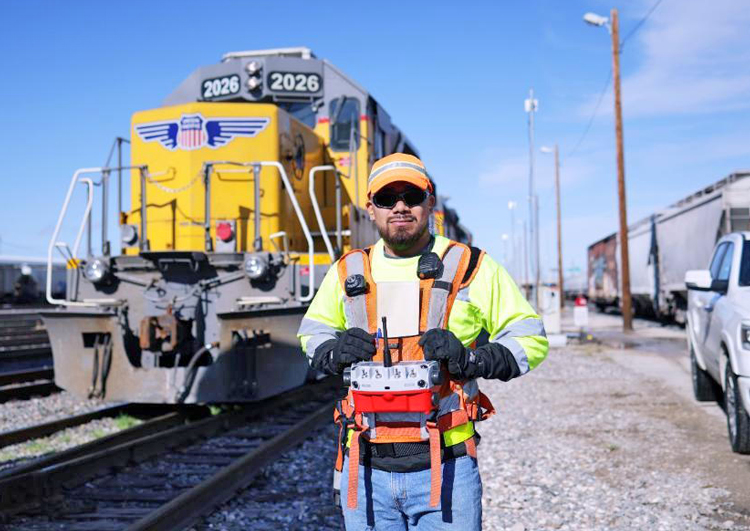LINCOLN, Neb. — As part of their drive to intensify the pace of labor and slash workers, rail bosses in the U.S. are stepping up use of one-person remote-control operation of trains hauling freight. And they’re running larger and longer trains in rail yards and nearby neighborhoods, some up to 160 cars.
This means one worker is running a 100-ton locomotive and its train consist with no one on board. It’s literally impossible to see what is happening around these trains.
The increase in remote-control operation is a product of their insatiable drive for profits. It goes along with their having reduced operating crews by a third in recent years and the elimination of inspectors, carmen and track-repair workers.
Rail unions are challenging this setup. And, in an initial report May 22, the Federal Railroad Administration admitted today’s longer and longer trains have “negative impacts on safety and performance.”
Railroad bosses claim remote-controlled trains have a better safety record, better than trains with crew members. But, as a May 27 New York Times article, “A 100-Ton Locomotive with No One in the Cab,” makes strikingly clear, the increasing number of injuries and deaths on remote-control operated trains belies that claim.
When the bosses introduced remote control operators in 2005, they agreed to limit using them to the confines of rail yards, away from inhabited neighborhoods. But now, the Times reports, they’re finding ways to extend remote operation miles into cities.
Growing numbers killed, maimed
The article lists numerous incidents of maiming and deaths of both rail workers and people who live near rail tracks.
Aron Iradukunda, a 9-year-old child, had his leg cut off while playing close to CSX railroad tracks in Buffalo, New York. He likely would have died if his sister hadn’t heard him scream and pulled him off the tracks. A few months later in 2023 Tyrina Mozee’s mutilated body was found a few blocks from where Iradukunda was maimed after she tried to get through the cars of a remote-controlled train that began moving.
Arnette Booker, Mozee’s aunt, was furious to find that there were no warnings that remote trains with no conductor or engineer onboard were passing through the residential neighborhood where children live and play.
“There’s no gate. There’s no sign saying, ‘No trespassing,’ no sign saying ‘Danger! Don’t come on the tracks.’ There’s no warning at all,” she told the Times.
In virtually every case when a human is maimed or killed, the Times said, rail bosses claim it’s the victim’s fault. But it’s the bosses’ profit drive that’s at fault.
Rail workers face the same dangers
Rail workers have been injured and killed on the job in remote control operator-related events. A CSX rail inspector, 56-year-old Frederick M. Anderson Jr., was hit and killed in September 2023 near Toledo, Ohio, when he stepped into the path of a remote-controlled locomotive, whose operator couldn’t see him. He was the third rail inspector since 2015 to die after being struck by a remote locomotive, sparking the Federal Railroad Administration to open a new review into remote operations.
Union Pacific bosses expanded their remote operations across the country, running trains of up to 160 cars, three times longer than the Federal Railroad Administration recommended in 2007.
In Houston, remote trains now run on a milelong section in the eastern part of the city, past family-run restaurants, bodegas, industrial warehouses and a school bus station. Some of these trains carry hazardous cargo, including hydrochloric acid and petroleum.
Last year, a man was found dead with his leg severed in a Houston area where remote locomotives were in use. Two years earlier, a woman in the same part of town lost both her legs after trying to cross between cars of a remote train that suddenly began moving. It’s impossible for workers running remotes to see all sides of a train, much less one 160 cars long.
In March of this year, a remote-controlled Union Pacific train hauled 128 cars, including 62 carrying hazardous materials, from Angleton to Freeport, Texas, a distance of 19 miles. The train ran through several communities with a combined population near 30,000, past 18 train crossings, five of them with no gates.
The SMART-TD rail union, which represents conductors and locomotive engineers, contends remote technology can be safe in some situations, but that railroads are cutting too many jobs, leaving more and more trains that should be handled by a crew of two or three, not operated by a single remote control operator.
Before this Militant worker-correspondent retired, I was a conductor when the norm was a five-person crew on freight trains — three workers on the locomotive and two workers riding in a rear caboose. Together they could see everything around the train. Rail yard crews had three on the ground working together doing switching work.
What is posed today is a clash between bosses’ profit drive and workers and their unions fighting for safe schedules and operating conditions.
“Railroad workers will need to start using their union power to control all work situations to eliminate the dangers to themselves and people who live and work near railroad tracks,” Lance Anton, a SMART-TD freight conductor working in Lincoln, told the Militant.
There is an example workers here can look to. A year ago, Laura Garza, a SMART-TD conductor and Socialist Workers Party candidate for U.S. Senate from California, visited Cuba and met with rail workers there.
In an example of gains Cuban workers made in their socialist revolution led by Fidel Castro, Garza reported Cuban rail workers’ schedules and shifts are in stark contrast to the long hours and scarce time off faced in the U.S.
A Cuban train consist working a 16-hour run is composed of two crews, both with a conductor, a conductor’s assistant, an engineer, assistant engineer and a mechanic/technical worker. One crew works the first eight hours, while the other crew members are assigned to a sleeping car. Then they switch. Rail workers have four days off before having to work again.


